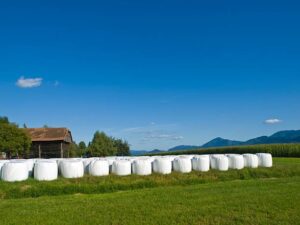A silage wrap is a plastic film that can help preserve your hay and make it easier to feed. It also helps prevent rain and melting snow from entering the bales, which could spoil the crop.
Its reflective white coating also helps reduce heat build-up, allowing for controlled anaerobic fermentation. It is easy to apply and can be used for a complete storage season. For quality silage wrap, check this out!
Tube wrapping
 The method you choose for wrapping your silage bales will significantly impact the quality and preservation of your feed. Two popular methods are tube wrapping and single-bale wrap. Each offers benefits and drawbacks, but which option is best for your farm or ranch?
The method you choose for wrapping your silage bales will significantly impact the quality and preservation of your feed. Two popular methods are tube wrapping and single-bale wrap. Each offers benefits and drawbacks, but which option is best for your farm or ranch?
Generally, it takes six film layers to limit oxygen and prevent spoilage. This number can vary depending on crop type, moisture, and storage conditions.
Spiral cable wrap is a unique and versatile way to organise wires, cables, and hoses into a bundle. It can be customised to fit your needs by choosing the pitch, diameter, wall thickness, colour, length, and more. It offers abrasion resistance and insulation properties while protecting the cables from vibrations. It also allows you to quickly reroute or replace the wires and cables in your bundles. This makes Heli-Tube an excellent choice for electrical work, industrial systems, and home projects.
Single bale wrapping
The goal of bale wrapping is to lock out air and limit the availability of oxygen, thereby preserving feed. This is accomplished by sealing the bale with multiple film layers, preventing oxidation and moisture. Wrapping also protects the hay crop from spoilage due to heat, fungi and pathogens. For quality silage wrap, check this out!
When a bale is wrapped with enough layers of plastic to limit the amount of oxygen, microorganisms that cause spoilage go dormant rather than continue eating nutrients and producing waste products like water and heat. This preserves nutrient content and increases feed value.
Propionic acid added at baling helps reduce heat production, an essential factor in preservation. Stacking the bales in a shaded, well-drained location also minimises handling and decreases the risk of damage to the plastic wrap. Check the wraps periodically for holes and tears that allow oxygen in, and repair them promptly. Handle the bales carefully, avoiding sharp stubble and rotted areas.
Underland FX
The Underland is a place of beauty and misery, of pop of wrack and kelp slicks, whale breach and sapphire veins of crevasse fields. It is also littered with plastic bottles and high-level nuclear waste, all a reminder of how humans tinker with nature. In Underland, Robert Macfarlane’s lyrical and heartfelt prose guides us downward to understand this special place.
Pensacola State’s Underground FX Lab has added a series of workshops for the first half of this year, starting with “Working with Latex” on Jan. 18 and 19. Students will learn to make bald caps, latex prosthetics, and latex sculptures. They will also know how to work with plaster and build two-piece moulds. Eric Dupre, founder of the Lab, says he often sees his workshop graduates take their new skills to paying jobs in the entertainment industry. He has worked in television production for over 20 years and runs a camera at WEAR-TV 3. The Lab is part of his full-service production company, Focus Pointe Productions. For quality silage wrap, check this out!
Silage Wrapping Film
The plastic silage wrap helps to preserve the freshness of your bales and prevents them from spoiling, so they are ready for use when converted into animal feed. It is made of high-quality materials that help to reduce contamination from foreign organisms. It also protects the crop from moisture, decreasing the risk of fungus growth.
A good silage wrap must withstand long periods of direct sunlight. This type of film is typically made from blown LLDPE and has a UV stabiliser, which prevents the plastic from breaking down quickly. It also contains a tack layer and elasticity, which creates a tight seal.
It is essential to harvest the forage before wrapping. This helps minimise air pockets and maximise density, allowing for a faster, more efficient wrapping process. In addition, it is essential to ensure that the surface of the bales or piles is clean and free from sharp objects that could puncture the wrap.